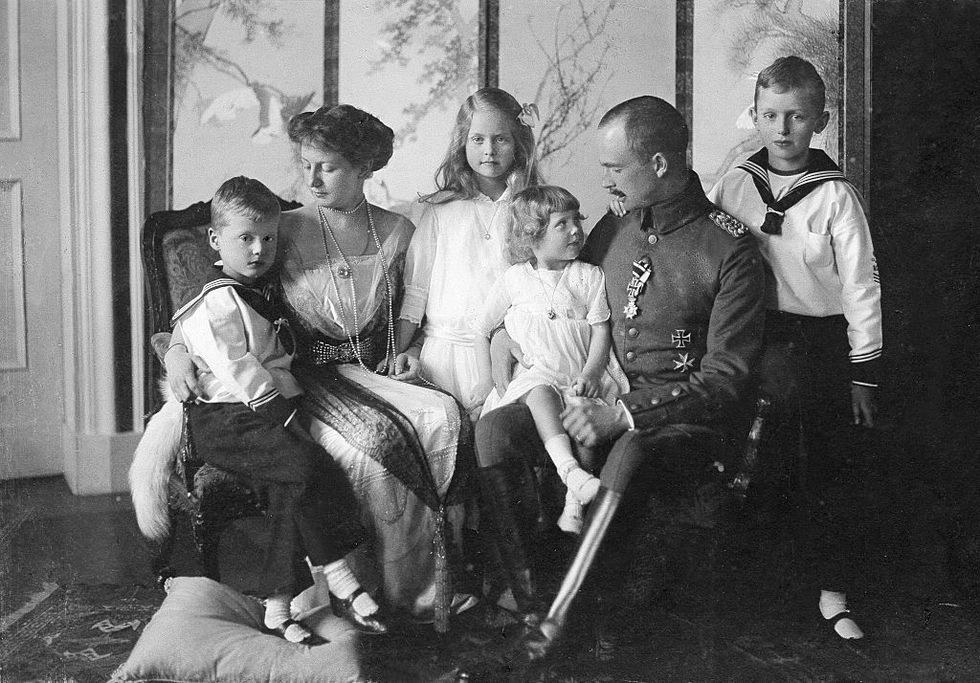#Is the Royal Family Connected to the Nazis? True Story, The Crown

Table of Contents
In the fifth season of The Crown, there’s a small, but telling moment during the scene when the royal family has learned of Mohammed Al Fayed’s renovation of the home of the Duke and Duchess of Windsor, which he calls “Villa Windsor.” Robert Fellowes, Queen Elizabeth’s private secretary, tells the Queen that Fayed has invited her to visit. “It seems there are all manner of valuable possessions at Villa Windsor, which we feel it would be important for the Crown to have back.” Among those possessions, Fellowes shares, is “material relating to his wartime stay in neutral Spain and Portugal, where he and the Duchess were frequently in the company of Nazis, who hoped to install him as a possible puppet king.”
While the line may have been missed by viewers, it’s a small glimpse into the Duke of Windsor’s controversial history—namely, his association with Nazi Germany, which was unpacked a bit in season two, episode six of the Netflix series. In the final season, too, The Crown touches on the Windsors and the Nazis when it recreates the moment Prince Harry wore a Nazi costume to a friend’s birthday party, something he’s discussed in recent years, calling it “one of the biggest mistakes of my life.”
Here, more on the British royal family’s various connections to the Nazis:
The connection begins with Charles Edward, the Duke of Saxe-Coburg and Gotha, a grandson of Queen Victoria
Prince Charles Edward was born in Surrey to Prince Leopold (Queen Victoria and Prince Albert’s eighth son) and Princess Helen of Waldeck and Pyrmont. The future Edward VII, then the Prince of Wales, was one of his godparents, and the future George V was his first cousin.
In 1900, a 16-year-old Prince Charles Edward inherited the Dukedom of Saxe-Coburg and Gotha in Germany, and started going by Karl-Eduard (or, in English, Carl Edward or Carl Eduard).
“It was a very great heartbreak for my mother that my brother had to succeed to Coburg. ‘I have always tried to bring Charlie up as a good Englishman,’ she once said, ‘and now I have to turn him into a good German,'” his sister, Princess Alice, Countess of Athlone, wrote in her memoirs For My Grandchildren.
When World War I broke out, he decided to support the German Empire, and served in the German army. Because of this, he was deemed a traitor and King George V removed him from the Most Noble Order of the Garter and stripped him of his British royal titles. In 1918, following the German Revolution, he lost his German titles—but not his wealth or property. (By this point, he was also exiled from the UK.)
In 1922, he met Adolf Hitler, and in 1933, he joined the Nazi Party. He soon rose in the ranks, and by 1936, he obtained the rank of ‘Obergruppenführer,’ or senior group leader. The same year, he went to Sandringham for King George V’s funeral, and Hitler instructed him to report back on his family.
He became president of the German Red Cross in 1933, and was extremely involved with the Nazi government during World War II. Following the war, the American Military Government in Bavaria placed him under house arrest, and then he was imprisoned until 1946 and charged with crimes against humanity, and subsequently fined by a Denazification court. He died in 1954 at age 69.
The Duke of Windsor’s Nazi sympathies
The most famous British royal sympathetic to the Nazis was King Edward III, who abdicated to marry Wallis Simpson. After his abdication, he became the Duke of Windsor, and upon their marriage in June 1937, Wallis became the Duchess of Windsor.
Shortly after his ascension, the German ambassador to the UK, Leopold von Hoesch, wrote to Berlin, “King Edward, quite generally, feels warm sympathy for Germany. I have become convinced during frequent, often quite lengthy, talks with him that his sympathies are deep-rooted and strong enough to withstand the contrary influences to which they are not seldom exposed.”
In 1997, former U.S. Foreign Service officer Paul Sweet published “The Windsor File,” wherein he wrote, “His pro-German feelings frequently found expression in indiscreet remarks that were not only insensitive to the brutalities of the Nazi regime but critical of ‘slip-shod democracy.’ In July 1933, he told former Kaiser Wilhelm II’s grandson, Prince Louis Ferdinand, that it was ‘no business of ours to interfere in Germany’s internal affairs either re Jews or re anything else.’ ‘Dictators are very popular these days,’ Edward had added. ‘We might want one in England before long.’
Yet, during his short tenure as monarch, he was deeply sympathetic to the Germans. In December 1936, Conservative MP Henry “Chips” Channon wrote in his diary Edward “is going the dictator way and is pro-German, against Russia and against too much slipshod democracy. I shouldn’t be surprised if he aimed at making himself a mild dictator—a difficult enough task for an English King.”
The Duke and Duchess of Windsor’s visit to Nazi Germany, and their exile during World War II
In summer 1937, soon after their wedding, the Windsors traveled to Nazi Germany, where they met many leaders—including Hitler himself, Goering, Himmler, and Goebbels. As Denis Judd wrote in his biography of King George VI, “The Duke and Duchess waxed enthusiastic about what they saw in Nazi Germany, particularly praising workers’ houses and conditions in the factories, hospitals, and youth camps.” The Duke of Windsor, reportedly, gave the Hitler salute on at least two occasions. The New York Times reported, “Before tea, Hitler showed his guests the house and grounds. They stood for some time on the terrace looking down into Austria, with the border town of Salzburg framed between the mountains.”
Two years later, in a speech from Verdun, France, the former King called for appeasement.
During World War II, however, the Duke of Windsor left Paris for Biarritz, France, then for Spain and Libson, Portugal. While he was in Spain and Portugal, he was open about being against the war. Viscount Caldecote, a member of Churchill’s cabinet, warned him that the Duke “is well-known to be pro-Nazi and he may become a center of intrigue.”
In fact, the German foreign minister, Joachim von Ribbentrop, wrote to his ambassador in Madrid, “Germany is determined to force England to peace by every means of power and upon this happening would be prepared to accommodate any desire expressed by the Duke, especially with a view to the assumption of the English throne by the Duke and Duchess.” Essentially, if Germany defeated England, they would reinstall Edward on the British throne.
So, Churchill’s solution? Get the Duke of Windsor out of Europe. He was appointed Governor of the Bahamas, where he lived with Wallis until 1945.
The Marburg Files of 1957 revealed the Duke’s communication with Nazis, which the Duke suggested were fabrications.
“His Royal Highness never wavered in his loyalty to the British cause,” Buckingham Palace said in a statement at the time. “The German records are necessarily a much tainted source. The only firm evidence which they provide is of what the Germans were trying to do in the matter, and of how completely they failed to do it.”
Queen Elizabeth’s alleged Nazi salute
In 2015, British tabloid The Sun published a 17 second black-and-white video clip that shows a young Princess Elizabeth offering a Nazi salute in 1933. The Sun says the film shows Edward VIII showing Princess Elizabeth and Princess Margaret how to do the salute. Buckingham Palace said it was “disappointing that film, shot eight decades ago… has been obtained and exploited.”
“Most people will see these pictures in their proper context and time. This is a family playing and momentarily referencing a gesture many would have seen from contemporary news reels,” a Palace source told BBC. “No-one at that time had any sense how it would evolve. To imply anything else is misleading and dishonest.”
Prince Philip’s sisters married Nazis
Prince Philip had four sisters, all of whom married members of the German aristocracy—three of those men became Nazis. (One sister, Princess Theodora married Berthold, Margrave of Baden; they tried to keep their distance from Nazism.) They all married before he married Queen Elizabeth, and thus became a part of the royal family, but the connection is still worth nothing.
His eldest sister, Princess Margarita, married Gottfried, the 8th Prince of Hohenlohe-Langenburg—a German aristocrat who joined the Nazi party and served in World War II. He was involved in Operation Valkyrie, the plot to assassinate Hitler in 1944.
Princess Cecilie, another sister, married German aristocrat Georg Donatus, Hereditary Grand Duke of Hesse. They joined the Nazis in May 1937, but died in a plane crash months later. At her funeral, Prince Philip marched with their relatives who wore Nazi uniforms.
His youngest sister, Princess Sophie, married Prince Christoph of Hesse, an Oberführer in the Nazi Party and a director in the Third Reich’s Ministry of Air Forces. Sophie said in her memoir of Hitler, “I have to say here, that, although Chri [Prince Chrisoph] and I changed our political view fundamentally some years later, we were impressed by this charming and seemingly modest man, and by his plans to change and improve the situation in Germany.”
Philip, notably, served for the British during World War II, and his mother, Princess Alice of Greece is recognized as a “Righteous Among Nations” by Israel’s Holocaust Museum, Yad Vashem, for sheltering a Jewish family during the war.
Prince Harry’s Nazi costume in 2005
Most recently, a 20-year-old Prince Harry wore a Nazi uniform to a costume party. He was condemned by many, and soon apologized. “I am very sorry if I caused any offense or embarrassment to anyone. It was a poor choice of costume and I apologize,” Harry said in a statement shared by Clarence House.
“The fact that the palace has issued an apology indicates that this was a mistake by the prince,” Rabbi Jonathan Romain, a spokesman for the Reform Synagogues of Great Britain, said at the time. “But having being given, the apology should now be accepted.”
In the third episode of Prince Harry and Meghan Markle’s docuseries, Harry & Meghan, Harry speaks about the Nazi costume incident. “It was probably one of the biggest mistakes of my life,” he shared. “I felt so ashamed afterwards.”
Harry writes about the moment in his memoir, Spare, saying his brother encouraged him to wear it. “I phoned Willy and Kate, asked what they thought. Nazi uniform, they said,” Harry writes. When he tried it on for him, he says, “They both howled. Worse than Willy’s leotard outfit! Way more ridiculous! Which, again, was the point.” In The Crown‘s final episode, this incident, and the ensuing fallout, is recreated.
Emily Burack (she/her) is the news writer for Town & Country, where she covers entertainment, culture, the royals, and a range of other subjects. Before joining T&C, she was the deputy managing editor at Hey Alma, a Jewish culture site. Follow her @emburack on Twitter and Instagram.
If you liked the article, do not forget to share it with your friends. Follow us on Google News too, click on the star and choose us from your favorites.
For forums sites go to Forum.BuradaBiliyorum.Com
If you want to read more News articles, you can visit our News category.







:max_bytes(150000):strip_icc():focal(861x412:863x414)/Colin-Burgess-obit-121623-01-ada647bb12be4d32894da7c05488dbc8.jpg)


